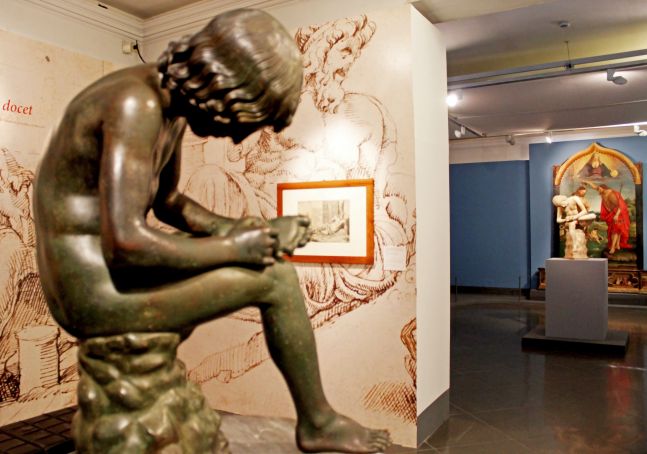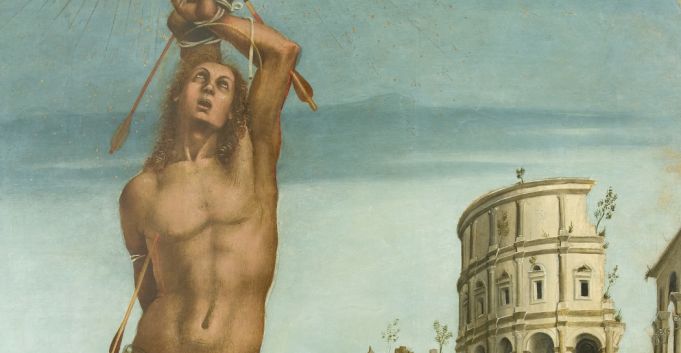Luca Signorelli and Rome. Oblivion and Rediscovery.
Luca Signorelli, most fortunate and most neglected among painters, was fortunate in his early patrons.
First there was Lorenzo de’ Medici; then came Sixtus IV for whom he painted two of the side-wall scenes in the Sistine Chapel. The artists originally commissioned, unable to meet the pope’s deadline, co-opted Signorelli as an assistant. He was fortunate again in that Sixtus supervised an archaeological golden age.
Ancient statues were being unearthed almost daily and were then displayed by papal order on the Campidoglio. Signorelli was quick to take advantage and inspiration. The Boy with a Thorn, as exhibited here, one statue in bronze, one in marble, is repeated in the background of two of his altar pieces.
Under Pope Julius II Signorelli suffered a downturn although things initially promised well. Bramante, Perugino, Pinturicchio, Perugino and Signorelli were invited to a working dinner to discuss decorations for a new wing, now known as the Raphael rooms. Work started promptly. Then, with just a few walls completed, it promptly stopped. Raphael, 33 years younger than Signorelli, had arrived. The works were not just stopped but were also painted over by Raphael.
Under Julius’s successor, Medici Pope Leo X, Signorelli, a favourite of the pope’s father, Lorenzo, back in Florence, must have expected better but the hoped-for plum commissions failed to materialise.

As this excellently curated exhibition narrates, Signorelli fell into virtual oblivion until his rediscovery in 1770s by Fuseli, then Canova. The German Nazarenes brought further recognition, then Degas and Cézanne whose monumental Bathers critics have been linked with Signorelli's equally monumental and infinitely more agile proto-types in Orvieto’s cathedral. More recently an essay by Geoff Dyer argues that Luca’s action-packed frescoes prefigure Captain Marvel and other comic strips of the 1950s and 60s.
Now to the works. A side-video documents the restoration of the St Sebastian’s Martyrdom altar piece which was commissioned after a 1497 visitation of the plague that took away Signorelli’s eldest daughter and young son in 1502. Sebastian was seen as a protector; he reputedly survived his ordeal by archery as depicted here, only to be cudgeled to death two years later. Down the pink Renaissance street a group of soldiers march the saint to his execution place; off left gazes stern-faced Emperor Diocletian and eroded versions of the Arch of Constantine and the Colosseum tower above.
More Roman connections feature in Christ on the Cross and Mary Magdalene. In an artistic first Signorelli reprises the inscription “Jesus of Nazareth, king of the Jews” in three languages, using as a model of the relic found, as legend has it, by Helen, Constantine’s mother and brought to Rome in the 5th century. The other link is the ruined Temple (The Forum’s Temple of Venus?) and a tiny Castel S. Angelo/Hadrian’s mausoleum. Lizard-threaded skull in front signals Golgotha; the circle of flowers, with Mary Magdalene at its centre, symbolising rebirth is depicted in great detail. This contrasts with the desolate landscape behind.

Room IV recreates Signorelli's masterwork, his Apocalypse sequence in Orvieto’s Duomo in brightly-illuminated virtual format. In the late 15th century many believed the End was nigh. Plague was rife and Constantinople had fallen to the Turks. Add to this the belligerent popes and French and Spanish invasions from the West. The most immediate effect for Signorelli, however, was the Medici’s expulsion from Florence (1494), and the rise of the Puritan and art-burning preacher / eventual heretic Savonarola. Signorelli had little difficulty in casting him as the Antichrist.
From Apocalypse to ‘luminous inner grace’. Room V displays three Madonnas. The queen of them is surely that painted shortly before (or during? or after?) the death of the artist’s wife Galizza and donated to their daughter Gabriella. Combining melancholy, tenderness and rigour, her gaze renders any halo unnecessary.
Oblivion and Rediscoveries is the subtitle of Federica Papi’s catalogue: the emphasis is in fascinatingly definitive favour of the latter.
By Martin Bennett
Musei Capitolini, Sale Espositive, Palazzo Caffarelli. Until 12 January 2020. For details see museum website.
Review published in the October 2019 edition of Wanted in Rome magazine.
General Info
View on Map
Review of Luca Signorelli exhibition in Rome
Piazza del Campidoglio, 1, 00186 Roma RM, Italy


















